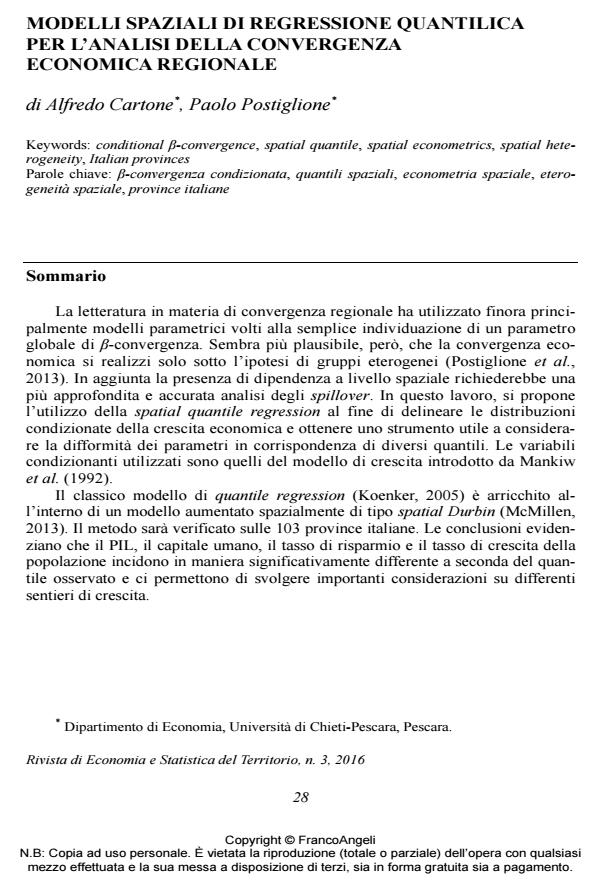Spatial quantile regressions for the analysis of regional economic convergence
Journal title RIVISTA DI ECONOMIA E STATISTICA DEL TERRITORIO
Author/s Alfredo Cartone, Paolo Postiglione
Publishing Year 2017 Issue 2016/3
Language Italian Pages 21 P. 28-48 File size 391 KB
DOI 10.3280/REST2016-003003
DOI is like a bar code for intellectual property: to have more infomation
click here
Below, you can see the article first page
If you want to buy this article in PDF format, you can do it, following the instructions to buy download credits

FrancoAngeli is member of Publishers International Linking Association, Inc (PILA), a not-for-profit association which run the CrossRef service enabling links to and from online scholarly content.
In the last decade, a noteworthy issue in regional economic growth studies has been represented by the convergence problem. Many researchers, according to Solow’s neoclassical growth model (1956), have noted that per-worker GDPs of poor regions tend to converge to those of richer regions. The assessment of this empirical tendency is a matter of primary relevance for policy makers. In this article the approach used is that of β-convergence (Barro and Sala-i-Martin, 1995). The paper estimates the conditional β-convergence model for 103 Italian provinces that correspond to NUTS 3 level of European Territorial Nomenclature.
Methods and Results
This study adopts a quantile regression approach that allows for the inclusion of spatial effects (McMillen, 2013). The model considered is a spatial Durbin specification of quantile regression estimated through a Double Stage Quantile Regression approach (Kim and Muller, 2004). The results highlight the importance of accounting for spatial dependence to increase representativeness and improve the estimated coefficients in the case of geographically distributed observations.
Conclusions
The empirical evidence shows that per-worker GDP, human capital, the savings rate and the rate of population growth influence have significant different behaviour depending on the quantile observed. These results enable us to carry out considerations on different paths of development of the Italian provinces and on effects of heterogeneous spillover.
Keywords: Conditional β-convergence, spatial quantile, spatial econometrics, spatial heterogeneity, Italian provinces
Jel codes: C01; C14; C21; C36; C52; O47
Alfredo Cartone, Paolo Postiglione, Modelli spaziali di regressione quantilica per l’analisi della convergenza economica regionale in "RIVISTA DI ECONOMIA E STATISTICA DEL TERRITORIO" 3/2016, pp 28-48, DOI: 10.3280/REST2016-003003